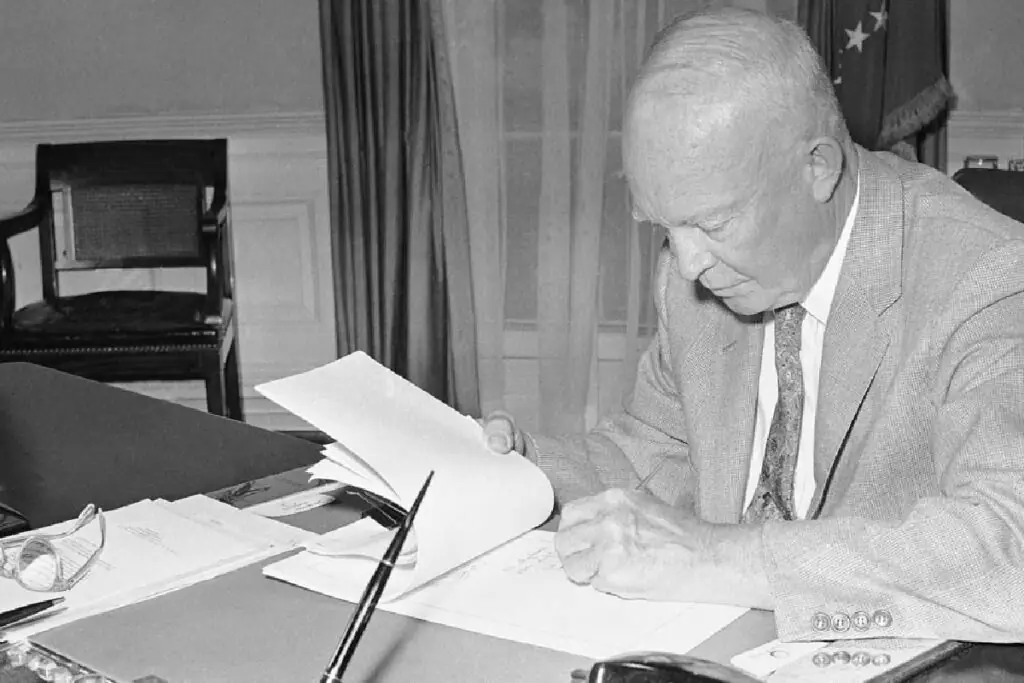The Eisenhower Doctrine, a pivotal moment in Cold War history, marked a significant shift in American foreign policy. It emerged against the backdrop of the Cold War’s growing tensions, specifically in the Middle East. This guide delves into the historical significance of the Eisenhower Doctrine, its background, key elements, its relationship with the Cold War, implementation, and eventual legacy.

✅ AI Essay Writer ✅ AI Detector ✅ Plagchecker ✅ Paraphraser
✅ Summarizer ✅ Citation Generator
Background of the Eisenhower Doctrine
The 1950s were a tumultuous period globally, characterized by the ideological struggle between the United States and the Soviet Union during the Cold War. The Middle East, strategically located and rich in resources, became a crucial battleground. The region faced an increasingly tense situation as superpower rivalry intensified.
The events that led to the formulation of the Eisenhower Doctrine were multifaceted. Key among them was the rise of Egyptian leader Gamal Nasser, whose anti-Western nationalism and burgeoning ties with the Soviet Union raised alarm bells in Washington. Another pivotal moment was Nasser’s nationalization of the Suez Canal in 1956, which prompted a coordinated attack by French, British, and Israeli military forces. Suddenly, the Middle East seemed poised to become the site of World War III.
President Dwight D. Eisenhower recognized the urgent need for a new American policy in the Middle East, one that would address these challenges and protect American interests in the region. It was against this backdrop that the Eisenhower Doctrine was conceived.
The Key Elements of the Eisenhower Doctrine
The doctrine’s core principles centered on combating the spread of communism and protecting American interests in the Middle East. It proposed a multifaceted approach that included both economic and military elements. Eisenhower aimed to launch new economic and military programs in the region to counter the influence of communism and safeguard American interests.
Economically, the doctrine sought to promote stability and development in the Middle East. It proposed economic assistance to friendly nations in the region, providing a counterweight to the appeal of Soviet support. Simultaneously, it envisioned the use of American military forces to secure and protect the territorial integrity and political independence of nations threatened by communism.
Cold War and the Middle East
The Middle East held a unique position in the broader Cold War strategy. Its vast oil reserves and geopolitical significance made it a focal point for both superpowers. The region was strategically positioned, serving as a bridge between Europe, Asia, and Africa. This geographical significance made it a prime target for Cold War influence.

The Eisenhower Doctrine was, therefore, a critical component of the broader Cold War strategy. It aimed to establish the Middle East as a Cold War battleground, ensuring that the United States maintained influence and prevented the spread of communism in this strategically vital region.
Implementation of the Eisenhower Doctrine
The Eisenhower Doctrine was not mere rhetoric. The United States took specific actions to implement it. Notable instances where the doctrine was invoked include the crisis in Lebanon in 1958. Civil strife in Lebanon led the nation’s president to request American assistance, resulting in the deployment of nearly 15,000 U.S. troops to quell the disturbances. This marked the doctrine’s first call to action.
The impact of the Eisenhower Doctrine on the region and U.S. foreign policy was substantial. It demonstrated America’s interest in Middle East developments and signaled its commitment to protecting its allies in the region. The doctrine played a pivotal role in shaping the geopolitics of the Middle East during the Cold War era.
Conclusion
The Eisenhower Doctrine remains a significant chapter in the history of American foreign policy. It exemplifies the United States’ efforts to counter communism during the Cold War and safeguard its interests in the strategically crucial Middle East. President Dwight D. Eisenhower’s vision for a comprehensive policy that combined economic and military programs left a lasting legacy, shaping the course of events in the region for years to come. As the world continues to grapple with the consequences of Cold War-era policies, the Eisenhower Doctrine serves as a reminder of the complexities and challenges faced during this pivotal period in history.
FAQ
Follow us on Reddit for more insights and updates.





Comments (0)
Welcome to A*Help comments!
We’re all about debate and discussion at A*Help.
We value the diverse opinions of users, so you may find points of view that you don’t agree with. And that’s cool. However, there are certain things we’re not OK with: attempts to manipulate our data in any way, for example, or the posting of discriminative, offensive, hateful, or disparaging material.